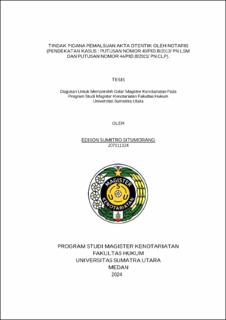| dc.contributor.advisor | Mulyadi, Mahmud | |
| dc.contributor.advisor | Sinaga, Henry | |
| dc.contributor.author | Situmorang, Edison Sumitro | |
| dc.date.accessioned | 2025-05-20T04:01:02Z | |
| dc.date.available | 2025-05-20T04:01:02Z | |
| dc.date.issued | 2024 | |
| dc.identifier.uri | https://repositori.usu.ac.id/handle/123456789/103932 | |
| dc.description.abstract | The potential to commit a crime depends on their professionalism in
working and the personal qualities of the Notary himself. In general, Notaries
who are caught in criminal cases are related to deeds made in front of them,
namely in the form of forgery of authentic deeds. The formulation of the problem
in this study is How is the formulation of the crime of forgery of authentic deeds in
criminal law?, What is the pattern of the crime of forgery of authentic deeds
committed by Notaries in the case: Decision Number Decision Number
40/Pid.B/2013/Lsm and Decision Number 44/Pid.B/2021/PN.Clp)? And How is
the Notary's responsibility for the crime of forgery of authentic deeds in Decision
Number Decision Number 40 / Pid.B / 2013 / Lsm and Decision Number 44 /
Pid.B / 2021 / PN.Clp?
This research is a normative legal research. This research is descriptive
analytical. The meaning is that from this research it is hoped that a detailed and
systematic picture of the problems being studied will be obtained. The analysis is
carried out based on the description, facts obtained and will be carried out
carefully to answer the problem in concluding a solution as an answer to the
problem.
The results of this study indicate that forgery of letters and falsifying
letters in their basic form are contained in Article 263 and Article 264 of the
Criminal Code. In Article 263 of the Criminal Code, the object of forgery is in the
form of a letter or document, while Article 264 of the Criminal Code is a criminal
act of forgery of letters which is aggravated in the form of an authentic deed.
Furthermore, Article 266 paragraph (2) of the Criminal Code is an important
part of forgery of documents, where there is an element of intent in it, namely
"intentionally using false or incorrect information in an authentic deed". The
object of forgery in Article 266 of the Criminal Code is in the form of false
information. Then the criminal act of forgery of deeds in Decision Number 40 /
Pid.B / 2013 / Lsm and Decision Number 44 / Pid.B / 2021 / PN.Clp has fulfilled
the elements contained in Article 264 of the Criminal Code, namely the element of
whoever makes a false letter and the element of an authentic deed that causes
harm to others. Furthermore, the Notary's responsibility in carrying out his duties
is civilly regarding the material truth of the deed he made, criminally regarding
the material truth of the deed he made, and based on the Notary Law and the
Notary's code of ethics. | en_US |
| dc.language.iso | id | en_US |
| dc.publisher | Universitas Sumatera Utara | en_US |
| dc.subject | Notary | en_US |
| dc.subject | Criminal | en_US |
| dc.subject | Authentic Deed and Forgery | en_US |
| dc.title | Tindak Pidana Pemalsuan Akta Otentik oleh Notaris (Pendekatan Kasus : Putusan Nomor 40/PID.B/2013/ PN.LSM dan Putusan Nomor 44/PID.B/2021/ PN.CLP). | en_US |
| dc.title.alternative | The Criminal Act of Forgery of Authentic Deeds By Notaries (Case Approach: Decision Number 40/PID.B/2013/PN.LSM and Decision Number 44/PID.B/2021/PN.CLP). | en_US |
| dc.type | Thesis | en_US |
| dc.identifier.nim | NIM207011024 | |
| dc.identifier.nidn | NIDN0001047403 | |
| dc.identifier.nidn | NIDN0104076802 | |
| dc.identifier.kodeprodi | KODEPRODI74102#Kenotariatan | |
| dc.description.pages | 136 Pages | en_US |
| dc.description.type | Tesis Magister | en_US |
| dc.subject.sdgs | SDGs 16. Peace, Justice And Strong Institutions | en_US |


